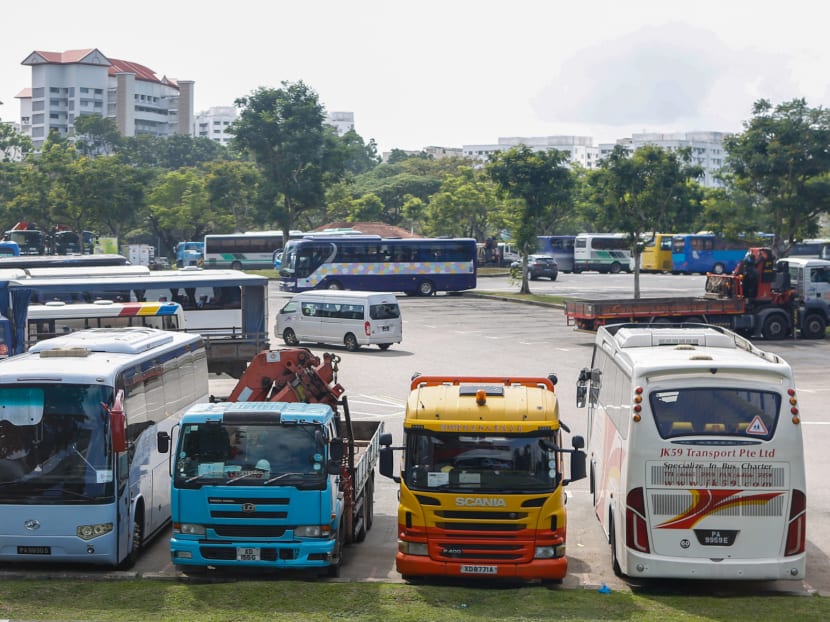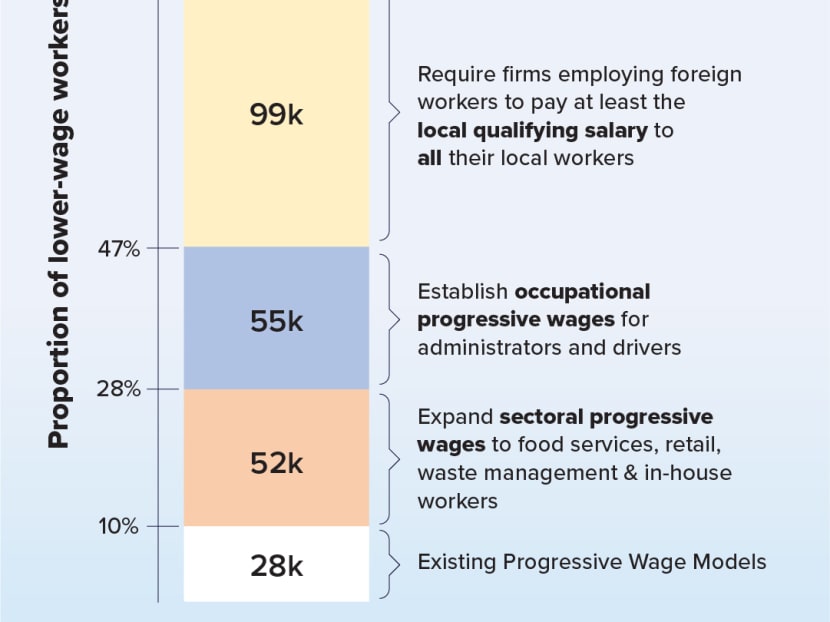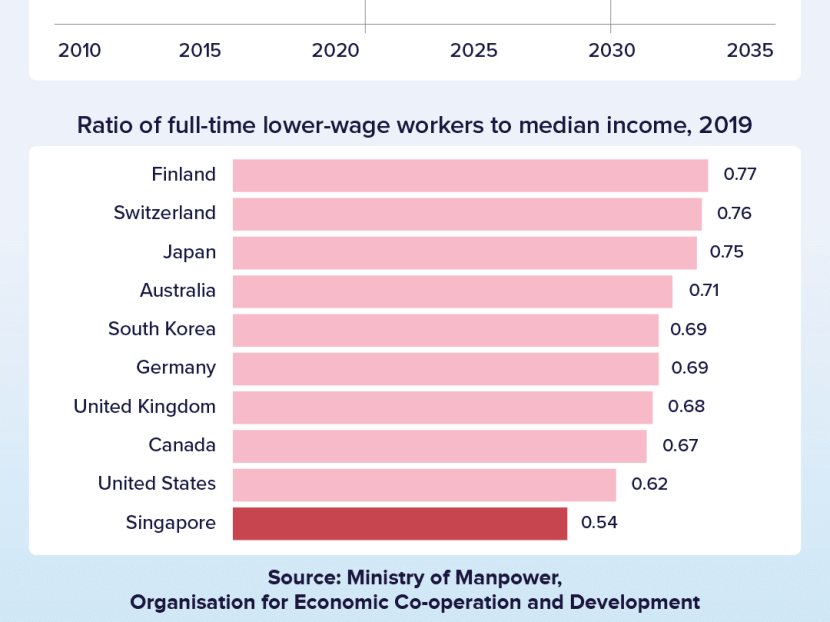55,000 administrators, drivers across all industries to get minimum salaries from March 2023
SINGAPORE — From March 2023, administrators in all companies across Singapore should be paid at least S$1,500 a month, while drivers should receive a minimum of S$1,750.

A tripartite workgroup is proposing that under the Progressive Wage Model, general drivers would get at least S$1,750 gross salary a month and specialised drivers would get at least S$1,850.
- From March 2023, the lowest rung of administrators should be paid at least S$1,500 and drivers at least S$1,750
- Firms that hire foreign workers must pay the all Singapore full-time employees at least S$1,400, or S$9 per hour for part-time workers
- The Progressive Wage Model for retail, food service and waste management sectors will begin as soon as September 2022
- These were among a list of 18 recommendations by a work group on low-wage workers
- Taken together, 82 per cent of lower-wage workers in Singapore will get some form of “progressive wages” from these moves
This is part of the expansion of the Progressive Wage Model to apply to specific occupations across more occupations and industries.
The Progressive Wage Model sets out minimum pay requirements for workers at different skill levels and mandates wage increases in tandem with the workers’ training and skills.
At the moment, it is applied only to specific sectors, namely the cleaning, security, landscaping and lift maintenance industries.
In announcing the move, a workgroup comprising representatives from the Government, employers and labour movement said that this new approach would help lift the wages of workers in common jobs across different sectors, where no clear leader can front wage negotiations.
The application of the wage model to all administrators and drivers will benefit some 55,000 lower-wage workers, they said.
The move was among a list of 18 recommendations published by the workgroup on Monday (Aug 30).
Mr Zaqy Mohamad, Senior Minister of State for Manpower who chaired the workgroup, said that the recommendations, when taken together, will ensure that 82 per cent of lower-wage workers in Singapore will receive some form of minimum level of progressive wages.
It was not easy to get employers to agree to the recommendations since they are facing economic headwinds, he said.
“We had tough conversations, but we agreed and achieved consensus on the outcomes, which will also minimise the risk of disemployment,” he added, referring to workers who may be dismissed due to the cost of higher wages.
The proposals, some of which were announced during Prime Minister Lee Hsien Loong’s National Day Rally speech on Sunday, have been accepted by the Government.
TODAY takes a closer look at some of the key recommendations.
OCCUPATIONAL PROGRESSIVE WAGES
The workgroup found that there were lower-wage jobs in many sectors, but it would not be possible to lift their wages easily as long as the Progressive Wage Model continues to be applied on a sectoral basis. Hence, the move to cover certain occupations across industries.
The workgroup will task the National Wages Council to recommend the annual wage growth for the selected occupations that will come under the wage model.
For administrators and drivers, the workgroup proposed the following gross monthly wage levels:
Admin assistants – At least S$1,500
Admin executives: – At least S$2,000
Admin supervisor – At least S$2,800
General drivers – At least S$1,750
- Specialised drivers – At least S$1,850
LOCAL QUALIFYING SALARY
From September next year, firms that hire any foreign workers must pay all their Singapore workers a local qualifying salary, which is now set at S$1,400 a month for full-time workers and S$9 an hour for part-time workers.
Some 99,000 lower-wage workers — defined as the bottom 20th percentile of income earners — are expected to benefit from the change.
Right now, companies have to pay the local qualifying salary to some Singapore employees — not all — depending on how many foreigners they hire.
The current system means that a services firm with 20 Singapore workers and five foreign workers, for example, need only pay 10 of their Singapore workers the local qualifying salary and not for the remaining 10.
This local qualifying salary will now be used to set the baseline salary for lower-wage workers not covered under the Progressive Wage Model.
During a news conference last Saturday ahead of the workgroup’s report launch, government officials stressed that the local qualifying salary, together with the wage model, is more effective for Singapore than a minimum wage system.
Mr Zaqy noted that most, if not all, minimum wage legislation around the world is also applied to foreign workers.
“To do that, I think, would destabilise a lot of moves that we are making. You would not get the same kind of gains for local workers.”
Mrs Josephine Teo, Minister for Communications and Information, said that employers have different obligations to resident and foreign workers that cannot be covered under the same minimum wage system.
“In the case of migrant workers, healthcare and accommodation — these things are the responsibility of the employers,” the former manpower minister, who advised the workgroup, said.
A minimum wage for foreign workers, on top of these existing obligations, might be too onerous on some businesses, she added.
The workgroup said that the local qualifying salary will continue to be used to determine the quota for work permits and S passes for foreign workers that a Singapore employer can hire.
That quota will remain unchanged.
The S Pass is for qualified mid-level skilled foreign workers who earn at least $2,500 a month. A work permit is generally issued to unskilled or semi-skilled migrant workers.
PROGRESSIVE WAGE FOR NEW SECTORS
The workgroup’s report also provided a timeline for the expansion of the Progressive Wage Model for three sectors that were earlier announced.
They are:
Retail, which will start from September 2022
Food services from March 2023
Waste management from sometime in 2023
Some 13,000 lower-wage workers in the retail sector and 15,000 in the food services industry will stand to benefit. No figures were provided for the number of lower-wage workers in the waste management sector.
Mr Ng Chee Meng, secretary-general of the National Trades Union Congress (NTUC) and member of the workgroup, said that the tripartite partners will continue pushing on expanding the wage model to more sectors.
They are now looking into pest management and strata management industries and these sectors could be next in line to be covered, he said.
The labour chief added that NTUC is not only looking at pushing out the Progressive Wage Model for lower-wage workers, it is also looking into sunrise sectors such as the sustainable energy sector, where the union can put in place a career development plan at the onset.

IN-HOUSE WORKERS
The Progressive Wage Model that is already in place for the cleaning, security, landscaping industries will also be extended to cleaners, security officers and landscape workers who are employed directly in-house for such roles across companies in different sectors from September 2022.
This will cover 24,000 full-time lower-wage workers in Singapore.
PROGRESSIVE WAGE MARK
Part of the recommendations by the workgroup was a new Progressive Wage Mark accreditation, also announced on Sunday by Mr Lee, to recognise firms that pay progressive wages.
It expects that this mark, together with pressure from market forces, will compel more companies to pay progressive wages to cover about 94 per cent of full-time lower-wage workers.
‘CATCH UP WITH THE MEDIAN’
Over the past 10 years, salaries of lower-wage workers have grown faster than the median wage in Singapore.
The real income, including employer Central Provident Fund contributions, of a full-time resident worker earning wages at the 20th percentile grew 39 per cent over this period, outpacing that of the median worker at 33 per cent.
However, the workgroup noted that the gap between the two groups of workers is still wider than in many advanced economies, including Japan, Switzerland, the United Kingdom and the United States.
As of June 2020, the gross monthly income of a worker at the 20th percentile (S$2,033) was about half that of the median income (S$4,000).
The workgroup attributed this to the fast growth of the median income, which it described as “remarkable for a developed economy”.
It still recommended that the baseline progressive wage growth for workers at the 20th percentile should outpace median wage growth.
“There remains significant ground for our lower-income workers’ wages to catch up with the median workers’,” its report noted.
“In the next bound, we want to redouble our efforts to uplift wages at the bottom and help lower-wage workers gain ground with other workers, enabling them to progress with the rest of our society.”












